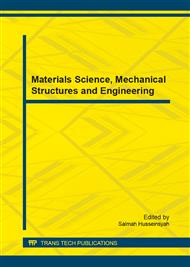[1]
V.S. Aigbodion, U. Akadike, S.B. Hassan, F. Asuke, J.O. Agunsoye, Development of Asbestos-Free Brake Pad Using Bagasse, Tribology in Industry, 32 (2010) 12-18.
Google Scholar
[2]
S.Y. Aku, D.S. Yawas, P.B. Madakson, S.G. Amaren, Characterization of Periwinkle Shell as Asbestos-Free Brake Pad Materials, The Pacific Journal of Science and Technology, 13 (2012) 57-63.
DOI: 10.1016/j.jksues.2013.11.002
Google Scholar
[3]
Y. Lu, A Combinatorial Approach for Automotive Friction Materials: Effects of Ingredients on Friction Performance, Composites Science and Technology, 66 (2006) 591-598.
DOI: 10.1016/j.compscitech.2005.05.032
Google Scholar
[4]
I. Mutlu, O. Eldogan, F. Findik, Tribological Properties of Some Phenolic Composites Suggested for Automotive Brakes, Tribology International, 39 (2006) 317-325.
DOI: 10.1016/j.triboint.2005.02.002
Google Scholar
[5]
H. Jang, K. Ko, S.J. Kim, R.H. Basch, J.W. Fash, The Effect of Metal Fibers on The Friction Performance of Automotive Brake Friction Materials, Wear, 256 (2004) 406-414.
DOI: 10.1016/s0043-1648(03)00445-9
Google Scholar
[6]
M.H. Cho, S.J. Kim, D. Kim, H. Jang, Effects of ingredients on tribological characteristics of a brake lining: an experimental case study, Wear, 258 (2005) 1682-1687.
DOI: 10.1016/j.wear.2004.11.021
Google Scholar
[7]
T.R. Jaafar, M.S. Selamat, R. Kasiran, Selection of Best Formulation for Semi-Metallic Brake Friction Materials Development, in: K. Kondoh (Ed. ) Powder Metallurgy, 2012, p.30.
DOI: 10.5772/33909
Google Scholar
[8]
K.H. Cho, M.H. Cho, S.J. Kim, H. Jang, Tribological Properties of Potassium Titanate in the Brake Friction Material; Morphological Effects, Tribology Letters, 32 (2008) 59-66.
DOI: 10.1007/s11249-008-9362-x
Google Scholar
[9]
R. Yun, P. Filip, Y. Lu, Performance and Evaluation of Eco-Friendly Brake Friction Materials, Tribology International, 43 (2010) 2010-(2019).
DOI: 10.1016/j.triboint.2010.05.001
Google Scholar
[10]
X. Xin, C.G. Xu, L.F. Qing, Friction properties of sisal fibre reinforced resin brake composites, Wear, 262 (2007) 736-741.
DOI: 10.1016/j.wear.2006.08.010
Google Scholar
[11]
H. Geren, R. Avcıoğlu, Y.T. Kavut, K. Tan, S. Sargın, In Turkish: Miscanthus sp. ve Sorghum sp. 'in Bornova Koşullarına Adaptasyonu Üzerinde Araştırmalar, in, Ege Üniversitesi Bilimsel Araştırma Projeleri, Bornova-İzmir/Turkey, 2013, p.65.
Google Scholar
[12]
H. Geren, R. Avcıoğlu, Y.T. Kavut, In Turkish: Filotu (Miscanthus x giganteus)'nun Bazı Morfolojik ve Agronomik Özellikleri Üzerine Araştırmalar, in: Türkiye 9. Tarla Bitkileri Kongresi, Bursa, 2011, pp.1708-1713.
Google Scholar
[13]
R.M. German, Powder Metallurgy and Particulate Materals Processing: The Processes, Materials, Products, Properties and Applications, Metal Powder Industries Federation, (2005).
Google Scholar
[14]
R.J. Talib, A. Muchtar, C.H. Azhari, The Performance Of Semi–Metallic Friction Materials For Passenger Cars, Jurnal Teknologi, 46 (2007) 53–72.
DOI: 10.11113/jt.v46.282
Google Scholar


